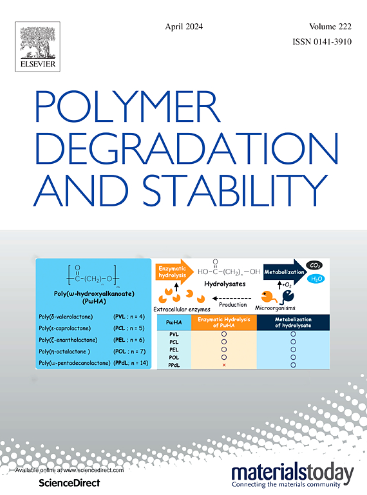Surface photooxidation of polypropylene-based photovoltaic backsheets: A comprehensive spectroscopic investigation
IF 6.3
2区 化学
Q1 POLYMER SCIENCE
引用次数: 0
Abstract
The prospect of cost reduction, enhanced performance, and improved sustainability has been driving innovation in the development of new backsheet materials for photovoltaic (PV) modules. Among the materials of interest, polypropylene (PP) has emerged as a promising alternative to fluoropolymer backsheets. As backsheets serve as a barrier providing electrical insulation and protection for the sensitive electrical components of PV modules, comprehensive understanding of the durability of PP-based backsheets is essential to ensure module reliability in the field.
In this study, free-standing coextruded PP backsheets were subjected to artificial weathering to elucidate the degradation behavior. The UV exposure was performed on the NIST Simulated Photodegradation via High Energy Radiant Exposure (SPHERE) under three environmental conditions: 75 °C and 50 % relative humidity (RH), 75 °C and 20 % RH, and 65 °C and 20 % RH. The total UV dose (295 nm to 400 nm) for each film was ≈1710 MJ/m2, or ≈50 years in Arizona, assuming 10 % albedo. Chemical, optical, and physical changes were monitored throughout exposure. Peak-resolving analysis was applied to attenuated total reflectance-Fourier transform infrared (ATR-FTIR) spectra to obtain functional group concentrations with respect to exposure. The greatest chemical and physical changes are seen after initial exposure (100 MJ/m2 to 220 MJ/m2), followed by a saturation point. Spectroscopic results indicate minor accumulation of oxidation products and additive migration. Raman spectroscopy showed a slight increase in crystallinity of the surface layers of the backsheets. Mechanical testing revealed low cracking propensity, with shallow cracks occurring under high strains.
求助全文
约1分钟内获得全文
求助全文
来源期刊

Polymer Degradation and Stability
化学-高分子科学
CiteScore
10.10
自引率
10.20%
发文量
325
审稿时长
23 days
期刊介绍:
Polymer Degradation and Stability deals with the degradation reactions and their control which are a major preoccupation of practitioners of the many and diverse aspects of modern polymer technology.
Deteriorative reactions occur during processing, when polymers are subjected to heat, oxygen and mechanical stress, and during the useful life of the materials when oxygen and sunlight are the most important degradative agencies. In more specialised applications, degradation may be induced by high energy radiation, ozone, atmospheric pollutants, mechanical stress, biological action, hydrolysis and many other influences. The mechanisms of these reactions and stabilisation processes must be understood if the technology and application of polymers are to continue to advance. The reporting of investigations of this kind is therefore a major function of this journal.
However there are also new developments in polymer technology in which degradation processes find positive applications. For example, photodegradable plastics are now available, the recycling of polymeric products will become increasingly important, degradation and combustion studies are involved in the definition of the fire hazards which are associated with polymeric materials and the microelectronics industry is vitally dependent upon polymer degradation in the manufacture of its circuitry. Polymer properties may also be improved by processes like curing and grafting, the chemistry of which can be closely related to that which causes physical deterioration in other circumstances.
 求助内容:
求助内容: 应助结果提醒方式:
应助结果提醒方式:


